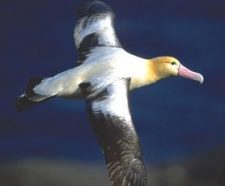Watery fate for nature’s gliders
Fossil bones hint that sea-level increases doomed Atlantic albatross populations.
Talk about winging it. The albatross is an amazing glider. In windy weather, these ocean birds can stay airborne for hours without flapping their enormous wings. They’ve been known to follow ships for days to feed on garbage.
Today, there are about 17 species of albatross, and they are found only in areas around Antarctica and the northern Pacific Ocean. Scientists know that albatross once soared over the Atlantic, but they’ve never understood why these birds might have died out—until now.
 |
|
It’s been about 400,000 years since short-tailed albatross glided over the Atlantic Ocean. The remaining members of this endangered species are now found only in Japan.
|
| H. Hasegawa, Toho University |
A new fossil discovery made in Bermuda suggests that the Atlantic population of at least one species of albatross, the short-tailed albatross, died out 400,000 years ago. Around this time, a period of global warming caused the polar ice caps to melt, making sea levels rise at least 20 meters.
That spelled trouble for the birds. The rising sea level left very little land on Bermuda, reducing the number of places the albatross could nest and breed.
Albatross must have nesting sites at high altitudes, and they need strong winds to make their gliding takeoffs and landings. In the Pacific Ocean, there are many more islands with high peaks than there are in the Atlantic Ocean. Researchers at James Cook University in Townsville, Australia, think that’s why the birds survived rising sea levels in the Pacific, but not in the Atlantic.
The Bermuda fossil find was surprising to scientists for another reason: The only other albatross fossils they had found before were from 5 million years ago. The latest fossils, which are only 400,000 years old, indicate that albatross were cruising over the Atlantic more recently than scientists had realized.
Today, the short-tailed albatross is an endangered species. The only surviving birds live in Japan. Let’s hope these and all albatross can keep gliding well into the future.







